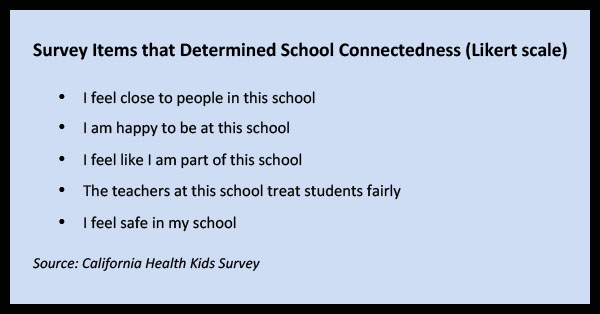Youth E-Cigarette Use and School Connectedness
By Xinran Cui Dhaliwal, MPH | March 20, 2018
Project Coordinator, ETR
Health promotion must take a multifaceted approach. It is the only path to success. This is one of my core beliefs.
It’s also something that resonated deeply for me at ETR’s recent All Staff Retreat—my first. When you meet everyone in this organization in one room at one time, you are struck by the fact that ETR staffers work in so many diverse areas of public health research and practice.
The Retreat also brought to mind the 5 Determinants of Health from Healthy People 2020:
- Policymaking
- Social factors
- Health services
- Individual behavior
- Biology and genetics
Complex Interactions in Health Equity
Each category goes in depth to describe factors that can shape population and individual health. In many ways, it is similar to ETR’s own Heath Equity Framework (HEF), which emphasizes interactions between individual factors, social networks, physiological pathways and systems of power.
.png) In our diagram, we show the complexity of health interactions through interlocking rings. Similarly, the 5 Determinants of Health came with a very astute note that, “It is the interrelationships among these factors that determine individual and population health.” As professionals in the public health discipline, some form of this framework has probably been instilled into each of us.
In our diagram, we show the complexity of health interactions through interlocking rings. Similarly, the 5 Determinants of Health came with a very astute note that, “It is the interrelationships among these factors that determine individual and population health.” As professionals in the public health discipline, some form of this framework has probably been instilled into each of us.
School Connectedness and E-cigarette Use
Fast forward to this past week, when I came across an example of this in the ATOD world (alcohol, tobacco and other drugs). An observation from the results of California Healthy Kids Survey found that vaping was more common among students with lower school connectedness. In other words, the social factor of low school connectedness interacts with individual behavior—the use of e-cigarettes.
This report adds to the growing trend of research finding increases in youth’s e-cigarette use, despite the downward trend for traditional cigarette smoking. Furthermore, the profile of e-cigarette users departs from that of cigarette smokers. Consequently, e-cigarette use is a disruptive threat to public health efforts towards tobacco control. This is requiring a realignment of our prevention strategies.
And so, the measure of school connectedness—a relatively new piece in these surveys—is just one example of how a wider variety of health determinants must be taken into consideration to identify the true at-risk population for e-cigarette use.
Adaptation is Already Happening
The adaptation in research efforts are well underway in the ATOD scientific community. Drs. Lauren Dutra and Stanton Glantz addressed the issues in a recent review. Reflecting on this data related to youth tobacco use from 2004-2014, Dr. Dutra remarked that, “While some of the kids using e-cigarettes were also smoking cigarettes, we found that kids who were at low risk of starting nicotine with cigarettes were using e-cigarettes [emphasis added].”
Also, in a publicly available lecture, Dr. Glantz showed data indicating that e-cigarette use is not only more prevalent in youths than smoking, it is also likely to evolve into smoking in young adulthood. Glantz and others are cautioning against this trend of e-cigarette popularity that is reaching our younger generations without the stigma that cigarettes now carry. While we recognize that e-cigarettes may not hold the same level of health risks as combustible products, we know that they do deliver a noxious cocktail of chemicals and produce detrimental habits.
E-cigarettes: As Insidious as Combustibles
The e-cigarette is as insidious as the combustible cigarette. It reaches children and youth in ever new and exciting ways. For example, there are the popular Fruit Loop flavored varieties that are clearly marketed toward a young demographic. The new Juul device looks like a flash drive and charges just like any other USB device. It can easily be used at school and dorms, even where use of all tobacco products is prohibited. (Check here for a collection of tweets that reveal just how attached users become to the Juul and its effects.)
One recent study found that adolescents who use e-cigarettes are more likely than adults to prefer fruit and alcohol flavored e-liquids. The more flavors adolescents identified as "preferred," the more frequent their use of e-cigarettes. Preferences for fruit, dessert and alcohol flavored liquids was also associated with more frequent use.
 A report by the National Academies of Sciences, Engineering and Medicine (NASEM) concludes, “There is substantial evidence that e-cigarette use increases risk of ever using combustible tobacco cigarettes among youth and young adults.” This is likely one of the drivers behind tobacco companies’ investment into their new marketing campaigns. (The NASEM report offers many other points of focus where there is either conclusive or substantial evidence related to the risks of e-cigarette products—well worth a look.)
A report by the National Academies of Sciences, Engineering and Medicine (NASEM) concludes, “There is substantial evidence that e-cigarette use increases risk of ever using combustible tobacco cigarettes among youth and young adults.” This is likely one of the drivers behind tobacco companies’ investment into their new marketing campaigns. (The NASEM report offers many other points of focus where there is either conclusive or substantial evidence related to the risks of e-cigarette products—well worth a look.)
New Methods, New Research, Same Fierce Resolve
Public health efforts, including ETR projects, are making an effort to reach youth before the tobacco companies take hold. We are finding new methods in evidence-based research and improving interventions and dissemination. ETR’s Tobacco Education Clearinghouse of California (TECC) project has many components in its work aimed to build capacity in our local tobacco control partners and coalitions.
We are funded by the California Tobacco Control Program (CTCP), which has a media campaign geared towards youth and young adults regarding e-cigarette use called “Still Blowing Smoke.” April Roeseler, Chief of the CTCP, wrote an earlier post describing one of their successful media-based e-cigarette prevention campaigns.
In addition to generating various fact sheets and special reports for the CTCP, we are also developing a Social Media Toolkit for community partners to help with their communication and media campaign efforts. Through technical assistance for CTCP partners, we are extending our experience in producing effective educational materials for specific audiences. We coordinate expert review of our materials for cultural, educational and language appropriateness, and aspire in a conscious way to bring greater equity to these strategies.
Collectively, TECC and other ETR projects are working to prevent tobacco and nicotine use and promote health. We use continuous improvement practice to improve our approaches iteratively. I am glad and proud to be part of such an organization.
Xinran Cui Dhaliwal, MPH is a Project Coordinator at ETR. She studied Neuroscience at UCLA and has focused much of her work on promoting health and education equity and empowering children and families with effective health resources. She can be reached at xinran.dhaliwal@etr.org.






